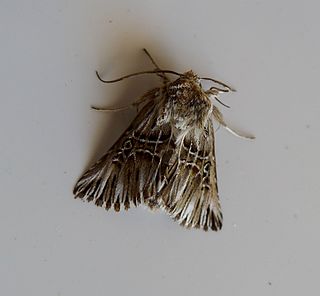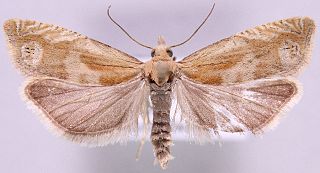
Scabiosa is a genus in the honeysuckle family (Caprifoliaceae) of flowering plants. Many of the species in this genus have common names that include the word scabious, but some plants commonly known as scabious are currently classified in related genera such as Knautia and Succisa; at least some of these were formerly placed in Scabiosa. Another common name for members of this genus is pincushion flowers.

Centaurea scabiosa, or greater knapweed, is a perennial plant of the genus Centaurea. It is native to Europe and bears purple flower heads.

Stenoptilia bipunctidactyla, also known as the twin-spot plume is a moth of the Pterophoroidea family found in North Africa, Asia and Europe. It was first described by the Austrian physician and naturalist, Giovanni Antonio Scopoli in 1763. It is one of four similar looking moths.

Omphalophana serrata is a moth of the family Noctuidae. It is found in Morocco, Portugal, Spain, Sardinia, Italy and Sicily.

Rhodostrophia calabra is a moth of the family Geometridae first described by Vincenzo Petagna in 1786. It is found from the Iberian Peninsula and a small isolated population in Morocco, through southern France, the western and southern Alps, Italy, the eastern coast of the Adriatic Sea to the southern parts of the Balkan Peninsula. In central Europe it is only found as an isolated population in central France and Rheinland-Pfalz. It is not found on the islands in the Mediterranean Sea. In the Balkans there is an isolated population in the border region of northern Bulgaria and Serbia. Furthermore, it is present on the eastern shores of the Black Sea in Turkey and in the Caucasus.
Stenoptilia annadactyla, also known as the small scabious plume, is a moth of the family Pterophoridae. It was first described by Reinhard Sutter in 1988 and is found in Europe.
Jordanita notata is a moth of the family Zygaenidae. It is found from the Iberian Peninsula and central Europe, through the northern part of the Mediterranean region to the Caucasus and Transcaucasia.
Agdistis hartigi is a moth in the family Pterophoridae. It is known from southern Spain, Italy, Greece and Tunisia.
Agdistis paralia is a moth in the family Pterophoridae. It is known from Spain, France, Italy, Malta, Greece, Israel, Turkmenistan, Tunisia, Algeria and Morocco. It has also been recorded from China (Gansu).
Capperia marginellus is a moth of the family Pterophoridae. It is found on Sicily, Cyprus and Turkey.
Stenoptilia stigmatodactylus is a moth of the family Pterophoridae. It is found in western, central and Mediterranean Europe, extending into Asia Minor and North Africa. It is also known from Iran, Russia and Armenia.
Wheeleria obsoletus is a moth of the family Pterophoridae. It is found in France, Italy, Austria, Sardinia, Sicily, the Czech Republic, Slovakia, Hungary, Croatia, Bosnia and Herzegovina, North Macedonia, Greece, Bulgaria, Romania, Ukraine, Belarus, Russia, Cyprus, Turkmenistan, Asia Minor and western Asia.
Gillmeria miantodactylus is a moth of the family Pterophoridae. It is found in France, Austria, Hungary, Romania, Bulgaria, North Macedonia, Ukraine, Russia and Asia Minor.
Hellinsia inulae is a moth of the family Pterophoridae. It is found on the Canary Islands, Iberian Peninsula, Corsica, Sardinia, Sicily, Cyprus and in Germany, Austria, Italy, the Czech Republic, Poland, Slovakia, Hungary, Croatia, Romania, Bulgaria, Bosnia and Herzegovina, North Macedonia, Greece, Russia, North Africa and Asia Minor.
Oidaematophorus giganteus is a moth in the family Pterophoridae. It is found on Sicily, Corsica and Sardinia and in Portugal, France and Italy.

Eucosma hohenwartiana, the bright bell, is a species of moth of the family Tortricidae. It is found in China, Central Asia, North Africa and Europe, where it has been recorded from Sardinia, Sicily, Ireland, Great Britain, Spain, France, Germany, the Benelux, Denmark, Austria, Switzerland, Italy, the Czech Republic, Slovakia, Slovenia, Hungary, Poland, Romania, Bosnia and Herzegovina, Norway, Sweden, Finland, the Baltic region and Russia. The habitat consists of dry open areas and grassland.

Cnephasia chrysantheana is a species of moth of the family Tortricidae. It is found in the Near East, Spain, France, Italy, Austria, the Czech Republic, Slovakia, Slovenia, Hungary, Romania, Ukraine and on Sicily and Sardinia.

Scabiosa columbaria, called the small scabious or dwarf pincushion flower, is a widespread species of flowering plant in the genus Scabiosa, native to Europe, Africa, and western Asia, from Sweden to Angola. In the garden it is a short-lived deciduous perennial. In the wild in Europe it prefers to grow in calcareous grasslands.

Pycnocomon is a genus of flowering plants belonging to the family Caprifoliaceae. They were formerly placed in the defunct family of Dipsacaceae.








